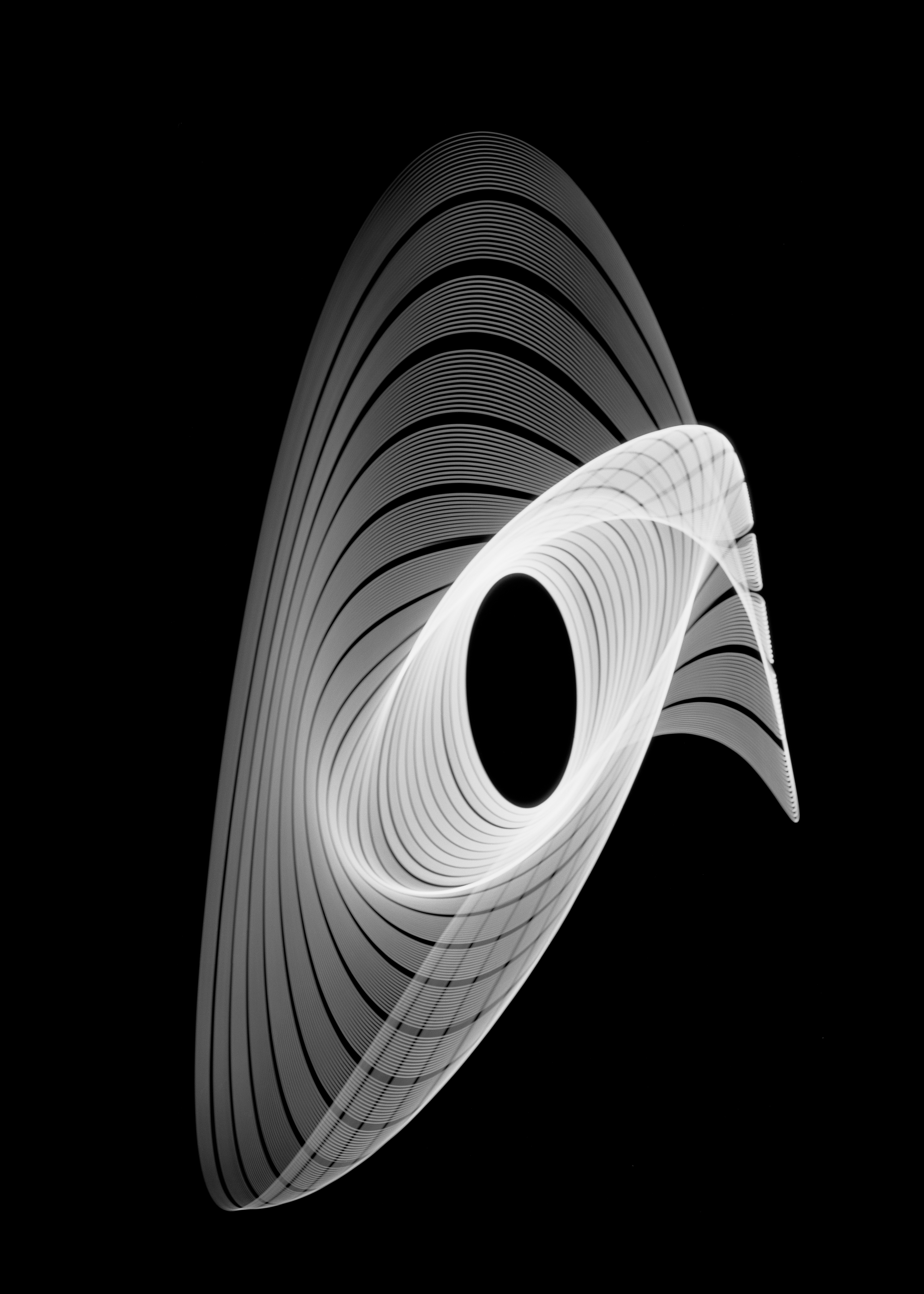

Heinrich Heidersberger’s rhytmograms can be described as calligraphic images, delicately curved compositions, abstract figures, organisms, and spaces woven from light. The artist created the complex patterns, which capture the invisible and fleeting of time and movement in singular image fields, during the 1950s and 1960s. Heinrich Heidersberger drew them using a self-developed photographic device, the rhythmograph, which transferred the geometry of the waves and oscillations of light, the elegant trajectory of the individual ray of light, to photographic material not through a camera but through a sophisticated, space-consuming apparatus, that he built, rebuilt, and adopted his own cameras and tools to. Heinrich Heidersberger saw the rhythmograph machine as a natural variant of the equipment of picture making, a machine for photography without cameras in the traditional sense. The rhythmograms bridge the future of algorithmically oriented architecture and art. They describe spaces freed from the heavy weight of material, dancing in the realm of pure form. The viewer experiences syncopated persistence of vision, as sensation that is not only visual but aural as well. The figures act as ghosts and residues of an externalized retina latency, scintillating traces of shimmering vibration. There is a hint of transcending space and time to harmonic figuration. Spirals: Infinitely returning but never precisely repeating, the Spirals evoke ramps, paths, staircases, means of scent or descent. They are among the most architectural of the rhythm grams; turning back on themselves endlessly, they seem to carve an interior space of delicate simplicity.
Heinrich Heidersberger’s rhythmograms explore the language of abstract formal structure in photography, with an intersection between geometry, technology, and perception. During the 1950s and 1960s, Heinrich Heidersberger created complex patterns that captured the invisible and fleeting of time and movement in singular image fields. Almost like an orchestra in motion that composes and traces the light onto the photographic plate through time and space. Heinrich Heidersberger developed a completely analog media art from this approach, which could hardly be created with digital means. The works seem part photography, parts sculpture, and parts architecture; they evoke a concrete sensibility that is both sensual and mathematical. The aesthetics of the rhythmograms are similar to the generative computer art of the Stuttgart School or artists like Herbert W. Franke and Manfred Mohr programmed generative processes with early mainframe computers.
03782_000_196
- PriceUSD PriceQuantityExpirationFrom
- PriceUSD PriceQuantityFloor DifferenceExpirationFrom
03782_000_196

- PriceUSD PriceQuantityExpirationFrom
- PriceUSD PriceQuantityFloor DifferenceExpirationFrom
Heinrich Heidersberger’s rhytmograms can be described as calligraphic images, delicately curved compositions, abstract figures, organisms, and spaces woven from light. The artist created the complex patterns, which capture the invisible and fleeting of time and movement in singular image fields, during the 1950s and 1960s. Heinrich Heidersberger drew them using a self-developed photographic device, the rhythmograph, which transferred the geometry of the waves and oscillations of light, the elegant trajectory of the individual ray of light, to photographic material not through a camera but through a sophisticated, space-consuming apparatus, that he built, rebuilt, and adopted his own cameras and tools to. Heinrich Heidersberger saw the rhythmograph machine as a natural variant of the equipment of picture making, a machine for photography without cameras in the traditional sense. The rhythmograms bridge the future of algorithmically oriented architecture and art. They describe spaces freed from the heavy weight of material, dancing in the realm of pure form. The viewer experiences syncopated persistence of vision, as sensation that is not only visual but aural as well. The figures act as ghosts and residues of an externalized retina latency, scintillating traces of shimmering vibration. There is a hint of transcending space and time to harmonic figuration. Spirals: Infinitely returning but never precisely repeating, the Spirals evoke ramps, paths, staircases, means of scent or descent. They are among the most architectural of the rhythm grams; turning back on themselves endlessly, they seem to carve an interior space of delicate simplicity.
Heinrich Heidersberger’s rhythmograms explore the language of abstract formal structure in photography, with an intersection between geometry, technology, and perception. During the 1950s and 1960s, Heinrich Heidersberger created complex patterns that captured the invisible and fleeting of time and movement in singular image fields. Almost like an orchestra in motion that composes and traces the light onto the photographic plate through time and space. Heinrich Heidersberger developed a completely analog media art from this approach, which could hardly be created with digital means. The works seem part photography, parts sculpture, and parts architecture; they evoke a concrete sensibility that is both sensual and mathematical. The aesthetics of the rhythmograms are similar to the generative computer art of the Stuttgart School or artists like Herbert W. Franke and Manfred Mohr programmed generative processes with early mainframe computers.